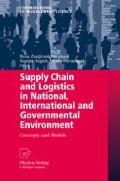Abstract
In today’s world, economic climate changes more quickly, and countries realize that globalization has made the world smaller and more competitive. Also, customers seek products and services that can respond to their specific needs and firms make effort to create competitive advantages to keep their profit and market share. All of the above trends lead firms and countries to focus on supply chain and integrated logistics (Fig. 4.1). Making supply chain activities more effective and efficient is a sustainable competitive advantage for countries. One of the important parts of these activities is logistics activities, which can make a significant reduction in costs. Efficient management of logistics activities is a perfect source for creating competitive advantages. Besides, it allows firms to respond to their customers’ specific needs, which in turn, results in customer satisfaction.
Access this chapter
Tax calculation will be finalised at checkout
Purchases are for personal use only
Notes
- 1.
Gross Domestic Product.
- 2.
Australian Federation of Travel Agents.
- 3.
North America Free Trade Agreement.
- 4.
Council of Supply Chain Management Professionals.
- 5.
Gross National Production.
- 6.
Purchasing Power Parity.
- 7.
Transportation Satellite Account and the U.S. Transportation Satellite Account was designed to produce estimates of all transportation operations for all modes.
- 8.
South Africa currency is Rand. 1 South Africa rand = 0.140313 US dollars.
- 9.
Small, medium and micro enterprises.
References
Amos P (2007) Responding to global logistics trends with a National Logistics Strategy. World Bank, Bangkok
Bookbinder JH, Tan CS (2003) Comparison of Asian and European logistics systems. Int J Phys Distrib Logist Manage 33(1):36–58
Bowersox DJ (1992) Framing Global Logistics Requirements, in Proceedings of the Council of Logistics Management. (Cincinnati, OH: Council of Logistics Management, 1992), pp. 267–277.
Bowersox DJ, Calantone RJ (1998) Executive insights: Global logistics, Journal of International Marketing, 6(4): 83–93.
Bowersox DJ, Calantone RJ, Rodrigues AM (2003) Estimation of global logistics expenditures using neural networks. J Bus Logist 24:21–36
Cooke JA (2006) Logistics costs under pressure. Logistics Management. In: 17th annual state of logistics report. http://www.logisticsmgmt.com/article/CA6352889.html.Accessed25Dec2007
Council of Supply Chain Management Professionals (2006) In: 17th annual state of logistics report of USA
CSIR Built Environment Center of Logistics (2004) The first state of logistics survey for South Africa. SIR Built Environment
Dalaney RV, Wilson R (2003) 14th Annual state logistics report: The case for reconfiguration, Washington, D: Cass Information Systems and ProLogis.
Fredendall LD, Hill E. (2001) Basics of Supply Chain Management, The St. Lucie Press, Boca Raton, Florida, USA.
Hausman WH, Lee HL, Subramanian U (2005) Global Logistics Indicators, Supply Chain Metrics, and Bilateral Trade Patterns. Policy Research Working Paper WPS 3773, World Bank, Washington, DC.
Heskett JL, Glaskowsky NA, Jr Ivie RM (1973) Business Logistics, 2nd ed., The Ronald Press, New York, NY, pp.14-21.
Logistics Survey (2006) http://www.tukkk.fi.Accessed25Dec2007
MacroSys Research and Technology (2005) Logistics costs and U.S. gross domestic product. Washington, DC
Radelet S, Sachs JD (1998) Shipping costs, manufactured exports, and economic growth. Mimeo
Rushton A, Croucher P, Baker P (2006) Handbook of logistics and distribution management, 3rd edn. The Chartered Institute of Logistics and Transport, UK, London
Themido I, Arantes A, Fernandes C, Guedes AP (2000) Logistic costs case study and ABC approach. J Oper Res Soc 51(10):1148–1157
Voortman C. (2004) Global Logistics Management, Juta Academic, Cape Town.
Wajszczuk K (2005) Logistics costs analysis as an assisting tool to achieve competitive advantage for agricultural enterprises. In: The XIth International Congress of the EAAE
Zeng AZ, Rossetti C (2003) Developing a framework for evaluating the logistics costs in global sourcing processes. Int J Phys Distrib Logist Manage 33(9):785–803
Author information
Authors and Affiliations
Corresponding author
Editor information
Editors and Affiliations
Rights and permissions
Copyright information
© 2009 Springer-Verlag Berlin Heidelberg
About this chapter
Cite this chapter
Pishvaee, M.S., Basiri, H., Sajadieh, M.s. (2009). National Logistics Costs. In: Zanjirani Farahani, R., Asgari, N., Davarzani, H. (eds) Supply Chain and Logistics in National, International and Governmental Environment. Contributions to Management Science. Physica-Verlag HD. https://doi.org/10.1007/978-3-7908-2156-7_4
Download citation
DOI: https://doi.org/10.1007/978-3-7908-2156-7_4
Published:
Publisher Name: Physica-Verlag HD
Print ISBN: 978-3-7908-2155-0
Online ISBN: 978-3-7908-2156-7
eBook Packages: Business and EconomicsBusiness and Management (R0)

